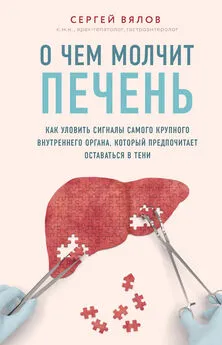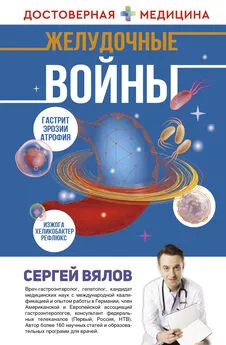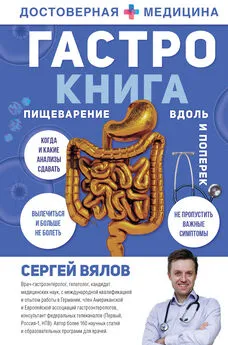Сергей Вялов - О чем молчит печень. Как уловить сигналы самого крупного внутреннего органа, который предпочитает оставаться в тени
- Название:О чем молчит печень. Как уловить сигналы самого крупного внутреннего органа, который предпочитает оставаться в тени
- Автор:
- Жанр:
- Издательство:Литагент 5 редакция «Пора лечиться правильно»
- Год:2020
- Город:Москва
- ISBN:978-5-04-110064-3
- Рейтинг:
- Избранное:Добавить в избранное
-
Отзывы:
-
Ваша оценка:
Сергей Вялов - О чем молчит печень. Как уловить сигналы самого крупного внутреннего органа, который предпочитает оставаться в тени краткое содержание
О чем молчит печень. Как уловить сигналы самого крупного внутреннего органа, который предпочитает оставаться в тени - читать онлайн бесплатно ознакомительный отрывок
Интервал:
Закладка:
4. Umemura T., Ota M. Genetic factors affect the etiology, clinical characteristics and outcome of autoimmune hepatitis. Clin J Gastroenterol . 2015 Dec. 8 (6): 360–366.
5. Czaja A.J. Diagnosis and management of autoimmune hepatitis. Clin Liver Dis . 2015 Feb. 19 (1): 57–79.
6. [Guideline] Gleeson D., Heneghan M.A. British Society of Gastroenterology. British Society of Gastroenterology (BSG) guidelines for management of autoimmune hepatitis. Gut . 2011 Dec. 60 (12): 1611–1629.
7. Floreani A., Rizzotto E.R., Ferrara F. et al. Clinical course and outcome of autoimmune hepatitis/primary sclerosing cholangitis overlap syndrome. Am J Gastroenterol . 2005 Jul. 100 (7): 1516–1522.
8. [Guideline] Manns M.P., Czaja A.J., Gorham J.D. et al. Diagnosis and management of autoimmune hepatitis. Hepatology . 2010 Jun. 51 (6): 2193–2213.
1. Gottesman L.E., Del Vecchio M.T., Aronoff S.C. Etiologies of conjugated hyperbilirubinemia in infancy: a systematic review of 1692 subjects. BMC Pediatr . 2015 Nov 20. 15: 192.
2. Gotze T., Blessing H., Grillhosl C., Gerner P., Hoerning A. Neonatal cholestasis – differential diagnoses, current diagnostic procedures, and treatment. Front Pediatr . 2015. 3: 43.
3. Davis A.R., Rosenthal P., Escobar G.J., Newman T.B. Interpreting conjugated bilirubin levels in newborns. J Pediatr . 2011 Apr. 158 (4): 562–565.e1.
4. Memon N., Weinberger B.I., Hegyi T., Aleksunes L.M. Inherited disorders of bilirubin clearance. Pediatr Res . 2016 Mar. 79 (3): 378–386.
5. van Dijk R., Beuers U., Bosma P.J. Gene replacement therapy for genetic hepatocellular jaundice. Clin Rev Allergy Immunol . 2015 Jun. 48 (2–3): 243–253.
6. Sticova E., Jirsa M. New insights in bilirubin metabolism and their clinical implications. World J Gastroenterol . 2013 Oct 14. 19 (38): 6398–6407.
1. Stanley S.L. Jr. Amoebiasis. Lancet . 2003 Mar 22. 361 (9362): 1025–1034.
2. Acuna-Soto R., Maguire J.H., Wirth D.F. Gender distribution in asymptomatic and invasive amebiasis. Am J Gastroenterol . 2000 May. 95 (5): 1277–1283.
3. Ralston K.S., Petri WA Jr. Tissue destruction and invasion by Entamoeba histolytica. Trends Parasitol . 2011 Jun. 27 (6): 254–263.
4. Tanyuksel M., Petri W.A. Jr. Laboratory diagnosis of amebiasis. Clin Microbiol Rev . 2003 Oct. 16 (4): 713–729.
5. Maltz G., Knauer C.M. Amebic liver abscess: a 15-year experience. Am J Gastroenterol . 1991 Jun. 86 (6): 704–710.
6. [Guideline] World Health Organization. Preventive chemotherapy to control soil-transmitted helminth infections in at-risk population groups.
7. Dold C., Holland C.V. Ascaris and ascariasis. Microbes Infect . 2011 Jul. 13 (7): 632–637.
8. Gangopadhyay A.N., Upadhyaya V.D., Gupta D.K. et al. Conservative treatment for round worm intestinal obstruction. Indian J Pediatr . 2007 Dec. 74 (12): 1085–1087.
9. Das A.K. Hepatic and biliary ascariasis. J Glob Infect Dis . 2014 Apr. 6 (2): 65–72.
10. Wani I. Gallbladder ascariasis. Turk J Gastroenterol . 2011. 22 (2): 178–182.
11. [Guideline] Brunetti E., Kern P., Vuitton D.A, Expert consensus for the diagnosis and treatment of cystic and alveolar echinococcosis in humans. Acta Trop . 2010 Apr. 114 (1): 1–16.
12. Macpherson C.N., Bartholomot B., Frider B. Application of ultrasound in diagnosis, treatment, epidemiology, public health and control of Echinococcus granulosus and E. multilocularis. Parasitology . 2003. 127 Suppl: S21–35.
13. Junghanss T., da Silva A.M., Horton J., Chiodini P.L., Brunetti E. Clinical management of cystic echinococcosis: state of the art, problems, and perspectives. Am J Trop Med Hyg . 2008 Sep. 79 (3): 301–311.
14. McManus D.P., Zhang W., Li J., Bartley P.B. Echinococcosis. Lancet . 2003 Oct 18. 362 (9392): 1295–1304.
15. Filippou D, Tselepis D, Filippou G, Papadopoulos V. Advances in liver echinococcosis: diagnosis and treatment. Clin Gastroenterol Hepatol . 2007 Feb. 5 (2): 152–159.
16. Parija S.C. Textbook of Medical Parasitology. Protozoology and Helminthology . 4 ed. New Delhi: All India: Publishers and Distributers; 2013.
17. Sakru N., Korkmaz M., Demirci M., Kuman A. Ok U.Z. Fasciola hepatica infection in echinococcosis suspected cases. Turkiye Parazitol Derg . 2011. 35 (2): 77–80.
18. Garcia L.S. Diagnostic Medical Parasitology . 5th ed. Washington, D.C: ASM Press; 2007.
19. Ubeira F.M., Muino L., Valero M.A., Periago M.V., Perez-Crespo I., Mezo M. MM3-ELISA detection of Fasciola hepatica coproantigens in preserved human stool samples. Am J Trop Med Hyg . 2009 Jul. 81 (1): 156–162.
20. Ezzat R.F., Karboli T.A., Kasnazani K.A., Hamawandi A.M.. Endoscopic management of biliary fascioliasis: a case report. J Med Case Rep . 2010 Mar 6. 4: 83.
1. Fleming R.E., Britton R.S., Waheed A. et al. Pathogenesis of hereditary hemochromatosis. Clin Liver Dis . 2004 Nov. 8 (4): 755–773, vii.
2. Adams P.C., Barton J.C. Haemochromatosis. Lancet . 2007 Dec 1. 370 (9602): 1855–1860.
3. Gattermann N. The treatment of secondary hemochromatosis. Dtsch Arztebl Int . 2009 Jul. 106 (30): 499–504, I.
4. Parkkila S., Niemela O., Britton R.S. et al. Molecular aspects of iron absorption and HFE expression. Gastroenterology . 2001 Dec. 121 (6): 1489–1496.
5. Allen K.J., Gurrin L.C., Constantine C.C. et al. Iron-overload-related disease in HFE hereditary hemochromatosis. N Engl J Med . 2008 Jan 17. 358 (3): 221–230.
6. Janssen M.C., Swinkels D.W. Hereditary haemochromatosis. Best Pract Res Clin Gastroenterol . 2009. 23 (2): 171–183.
7. Gurrin L.C., Bertalli N.A., Dalton G.W. et al. HFE C282Y/H63D compound heterozygotes are at low risk of hemochromatosis-related morbidity. Hepatology . 2009 Jul. 50 (1): 94–101.
8. Brissot P. Optimizing the diagnosis and the treatment of iron overload diseases. Expert Rev Gastroenterol Hepatol . 2016. 10 (3): 359–370.
9. Dusek P., Roos P.M., Litwin T., Schneider S.A., Flaten T.P., Aaseth J. The neurotoxicity of iron, copper and manganese in Parkinson’s and Wilson’s diseases. J Trace Elem Med Biol . 2015 Jul. 31: 193–203.
10. Rodriguez-Castro K.I., Hevia-Urrutia F.J., Sturniolo G.C. Wilson’s disease: A review of what we have learned. World J Hepatol . 2015 Dec 18. 7 (29): 2859–2870.
11. Schilsky M.L. Wilson disease: diagnosis, treatment, and follow-up. Clin Liver Dis . 2017 Nov. 21 (4): 755–767.
12. Roberts E.A., Schilsky M.L. American Association for Study of Liver Diseases (AASLD). Diagnosis and treatment of Wilson disease: an update. Hepatology . 2008 Jun. 47 (6): 2089–2111.
13. Weiss K.H., Thurik F., Gotthardt D.N. et al. Efficacy and safety of oral chelators in treatment of patients with Wilson disease. Clin Gastroenterol Hepatol . 2013 Aug. 11 (8): 1028–1035.e2.
14. Gerosa C., Fanni D., Congiu T. et al. Liver pathology in Wilson’s disease: from copper overload to cirrhosis. J Inorg Biochem . 2019 Jan 15. 193: 106–111.
1. Solis Herruzo J.A., Solis Munoz P, Munoz Yague T. The pathogenesis of primary biliary cirrhosis. Rev Esp Enferm Dig . 2009 Jun. 101 (6): 413–423.
2. Selmi C., Gershwin M.E. The role of environmental factors in primary biliary cirrhosis. Trends Immunol . 2009 Aug. 30 (8): 415–420.
3. Lindor K., Dickson R. Primary biliary cirrhosis. Schiff ER, Sorrell MF, Maddrey WC, eds. Schiff’s Diseases of the Liver . 8th ed. Lippincott-Raven: Philadelphia; 1999. Vol 1: 679–692.
4. Pares A., Caballeria L., Rodes J. Excellent long-term survival in patients with primary biliary cirrhosis and biochemical response to ursodeoxycholic Acid. Gastroenterology . 2006 Mar. 130 (3): 715–720.
5. Ricci P, Therneau T.M., Malinchoc M. et al. A prognostic model for the outcome of liver transplantation in patients with cholestatic liver disease. Hepatology . 1997 Mar. 25 (3): 672–677.
1. Tsochatzis E.A., Bosch J., Burroughs A.K. Liver cirrhosis. Lancet . 2014 May 17. 383 (9930): 1749–1761.
2. Friedman S.L. Hepatic fibrosis. Schiff ER, Sorrell MF, Maddrey WC, eds. Schiff’s Diseases of the Liver . 8th ed. Philadelphia, Pa: Lippincott-Raven; 1999. 371–385.
3. Freeman R.B. Overview of the MELD/PELD system of liver allocation indications for liver transplantation in the MELD era: evidence-based patient selection. Liver Transpl . 2004 Oct. 10 (10 Suppl 2): S2–3.
4. [Guideline] European Association for the Study of the Liver. EASL clinical practice guidelines for the management of patients with decompensated cirrhosis. J Hepatol . 2018 Aug. 69 (2): 406–460.
5. [Guideline] European Association for the Study of the Liver. EASL clinical practice guidelines: management of hepatocellular carcinoma. J Hepatol . 2018 Jul. 69 (1): 182–236.
6. Lubel J.S., Angus P.W. Modern management of portal hypertension. Intern Med J . 2005 Jan. 35 (1): 45–49.
7. Sanyal A.J., Bosch J., Blei A., Arroyo V. Portal hypertension and its complications. Gastroenterology . 2008 May. 134 (6): 1715–1728.
8. Kim T.Y., Jeong W.K., Sohn J.H., Kim J., Kim M.Y., Kim Y. Evaluation of portal hypertension by real-time shear wave elastography in cirrhotic patients. Liver Int . 2015 Nov. 35 (11): 2416–2424.
9. Sass D.A., Chopra K.B. Portal hypertension and variceal hemorrhage. Med Clin North Am . 2009 Jul. 93 (4): 837–853, vii-viii.
10. Arroyo V., Gines P., Gerbes A.L. et al. Definition and diagnostic criteria of refractory ascites and hepatorenal syndrome in cirrhosis. International Ascites Club. Hepatology . 1996 Jan. 23 (1): 164–176.
11. Caldwell S.H., Battle E.H. Ascites and spontaneous bacterial peritonitis. Schiff ER, Sorrell MF, Maddrey WC, eds. Schiff’s Diseases of the Liver . 8th ed. Philadelphia, Pa: Lippincott-Raven; 1999. 371–385.
12. Kiser T.H., Maclaren R., Fish D.N. Treatment of hepatorenal syndrome. Pharmacotherapy . 2009 Oct. 29 (10): 1196–1211.
13. Hou W., Sanyal A.J. Ascites: diagnosis and management. Med Clin North Am . 2009 Jul. 93 (4): 801–817, vii.
14. Ahboucha S., Pomier-Layrargues G., Butterworth R.F. Increased brain concentrations of endogenous (non-benzodiazepine) GABA-A receptor ligands in human hepatic encephalopathy. Metab Brain Dis . 2004 Dec. 19 (3–4): 241–51.
15. Ahboucha S., Butterworth R.F. The neurosteroid system: an emerging therapeutic target for hepatic encephalopathy. Metab Brain Dis . 2007 Dec. 22 (3–4): 291–308.
16. Butterworth R.F. Neurosteroids in hepatic encephalopathy: Novel insights and new therapeutic opportunities. J Steroid Biochem Mol Biol . 2016 Jun. 160: 94–97.
17. Shawcross D.L., Dunk A.A., Jalan R. et al. How to diagnose and manage hepatic encephalopathy: a consensus statement on roles and responsibilities beyond the liver specialist. Eur J Gastroenterol Hepatol . 2016 Feb. 28 (2): 146–152.
18. Frederick R.T. Current concepts in the pathophysiology and management of hepatic encephalopathy. Gastroenterol Hepatol (N Y) . 2011 Apr. 7 (4): 222–233.
Читать дальшеИнтервал:
Закладка:










